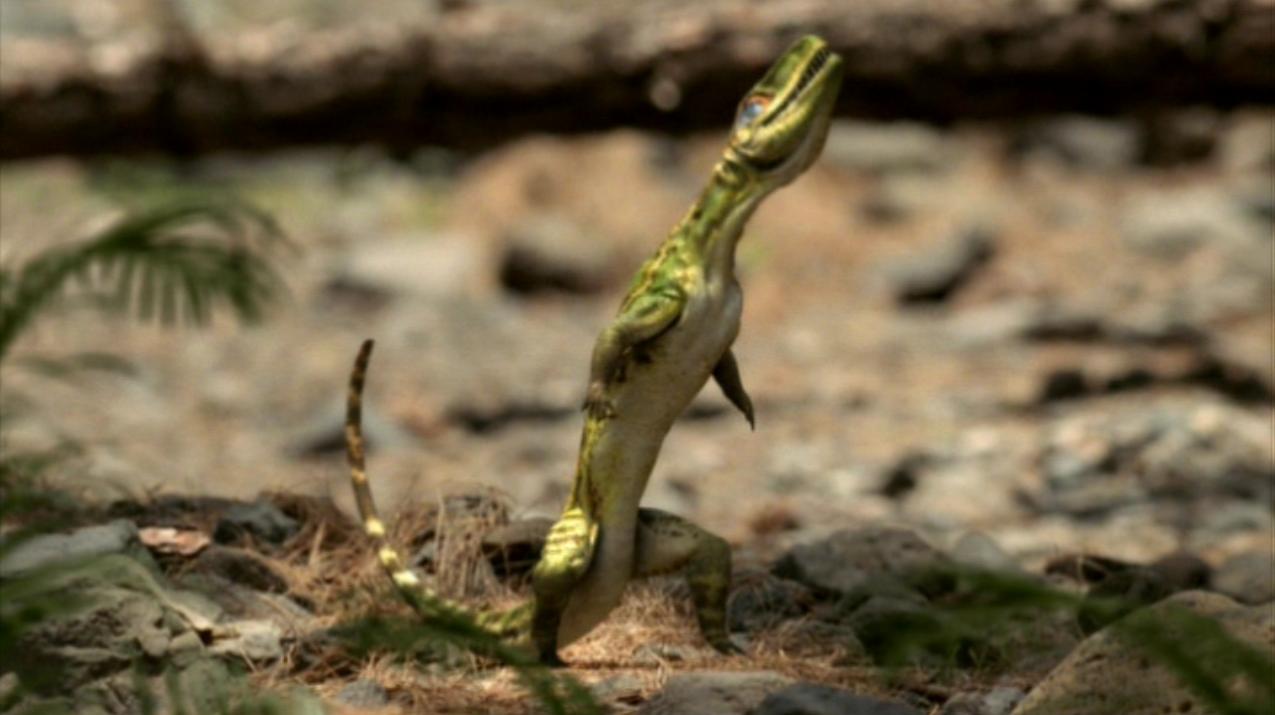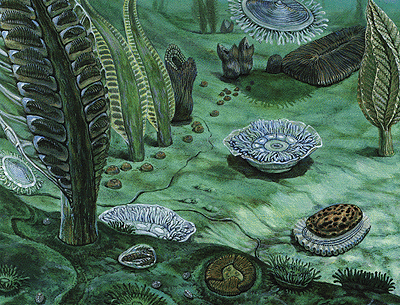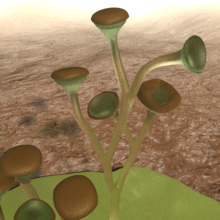(The diverse range of life during the Cambrian 541-485 million years ago)
You may be forgiven for believing that dinosaurs were the earliest animals to appear. After all, when was the last time you heard such famous names as Dimetrodon (Cope, 1878), Ichthyostega (Save-Soderbergh, 1932) or Vinlandostrophia (Zuykov and Harper, 2007), all of which predate dinosaurs by a considerable amount of time. In this article, we will look at the major steps life took to get from the earliest, simplest forms of life to becoming a dinosaur.
(Stromatolite colonies at Shark Bay, Australia)
The oldest fossils found have been dated to about 3.4 billion years ago, single-celled organisms that used sulphur rather than oxygen (Wacey et al., 2011) (we'll be looking at the origin of life and the origin of Earth another day). Such organisms are still around today. They are called cyanobacteria and are found in anaerobic (oxygen-less) environments, the most famous examples being stromatolites.
(Life in the Pre-Cambrian)
Towards the end of the Pre-Cambrian, about 635-542 million years ago, the first true multicellular lifeforms appeared. They are called the Ediacara biota, after the Ediacara Hills, Australia where many fossils have been found (Termier and Termier, 1960). Most of them just look like blobs of jelly, and indeed, many of them are still not universally accepted as being fossils. Along with this, their identity and where they fit into the tree of life, has remained a topic of much debate. Ideas have included: cnidarians (jellyfish, sea anemones, corals etc.) (Donovan and Lewis, 2001), the universal ancestors of all the animals (Glaessner, 1984), completely different forms of life that no longer exist (Seilacher, 1984), lichens (Retallack, 1994), algae (Ford, 1958), amoebae (Zhuravlev, 1992), fungi (Peterson et al., 2003) or bacterial colonies (Grazhdankin, 2001). Whatever they were, we'll be looking at them in more detail at a later date.
(Jellyfish Chrysaora fuscescens (Brandt, 1835))
At the start of the Cambrian, around 542 million years ago, something strange happened. The previous Ediacaran fauna, consisting of blob-things, largely disappeared (some persisting as late as the Mid Cambrian (Conway Morris, 1993)) and were replaced by organisms with hard parts (such as bone, teeth, shells etc.) and that resembled modern organisms such as jellyfish, molluscs and even vertebrates. This has been termed the "Cambrian Explosion of Life". But what happened? Where did these gribblies come from? And where did the Ediacaran "animals" go? These questions will be investigated some other day.
(Cooksonia (Lang, 1937), an early land plant)
The next major step for life was the colonisation of land. The earliest evidence for terrestrial life is found in rocks about 490 million years old. These fossils are of footprints believed to have been left by a strange group of amphibious arthropods called euthycarcinoids, which are regarded as being closely related to the myriapods (centipedes, millipedes and some other groups of long, multi-legged arthropods) (MacNaughton et al., 2002). Plants first appeared on land during the Mid Ordovician, around 476 million years ago. The evidence for this is based on spores of land plants similar to liverworts. The earliest definite land plant fossils are from 430 million-year-old rocks and belonged to a group called the club-mosses (Kenrick and Crane, 1997).

The tetrapods first appeared about 395 million years ago, evolving from the sarcopterygian fish (although precisely which group is unclear at this time). Many tetrapods have been discovered, some resembling fish, some resembling amphibians and reptiles and others somewhere in between (dubbed "fishapods" by some). The exact placement of many of these taxa is unknown. But they are important because they were the forerunners of all amphibians, reptiles, birds and mammals that have ever existed.
(Helicoprion, (Karpinsky, 1899), an early shark-like fish)
The ancestors of the fish probably appeared about 530 million years ago and resembled short, fat eels (Shu et al., 1999). These first fish were jawless like today's lampreys and hagfish. Later, around 500-430 million years ago, large armoured jawless fish, called ostracoderms, appeared. Not long after, 420 million years ago, the first jawed fish appeared. The jawed fish proved to be very successful and the jawless fish declined, mostly going extinct at the end of the Devonian, 358 million years ago. The first jawed fish to appear, the Placoderms, were heavily armoured. They also went extinct at the end of the Devonian. Another early group were the Acanthodians or "spiny sharks" (they weren't sharks). The Acanthodians went extinct at the end of the Permian, 250 million years ago. The cartilaginous fish first appeared in the Middle Devonian, 395 million years ago. Today, three groups still exist: the chimaerae (also called elephantfish, ghostfish and rabbitfish), the sharks and the rays. The next major group of fish to appear, the bony fish or Osteichthyes appeared about 416 million years ago. They are made up of two groups: the Actinopterygii (the ray-finned fish) and the Sarcopterygii (the fleshy-finned fish). The former contains the vast majority of living fish. The latter includes the coelacanths, lungfish and the ancestors of the Tetrapods (amphibians, reptiles, birds and mammals).


(Acanthostega (Jarvik, 1952), an early tetrapodomorph)

(Euparkeria (Broom, 1913), an archosaur)
From those early tetrapodomorphs emerged all the amphibians, reptiles, birds and mammals. Other than when they first appeared, the amphibians have never really been the dominant animals on land. One of these early amphibian groups (and it's not clear which) gave rise to the amniotes. The amniotes are the reptiles, birds and mammals. They have been more successful than amphibians because they can lay their eggs in dry environments. Reptiles first appeared around 313 million years ago (Benton and Donoghue, 2007). Initially, it was the reptiles that gave rise to the mammals, the Synapsids, that ruled. This lasted until the Permian mass extinction, the largest mass extinction ever, wiped out nearly 90% of all life on Earth (Benton, 2005). After this extinction, the Diapsid reptiles (lizards, snakes, dinosaurs, crocodiles, pterosaurs, marine reptiles and possible tortoises) became more abundant. One of these groups, the Archosaurs, became the dominant terrestrial life forms from the Mid Triassic (Benton, 1983). From this group emerged the crocodiles, pterosaurs (maybe), birds and the dinosaurs.
And that brings us up to speed. As you can see, a lot happened before the Dinosaurs appeared. The next time-based post will be about the Mesozoic, the era in which the dinosaurs lived. However, the next post will be the second part of the Jurassic Park series, examining the issues surrounding the raptors.
See also:
More dinosaurs
Geochronology
Age of the Dinosaurs
See also:
More dinosaurs
Geochronology
Age of the Dinosaurs
References
Benton, M. (1983) 'Dinosaur Success in the Triassic: a Noncompetitive Ecological Model', Quarterly Review of Biology, 58 (1), pp. 29-55
Benton, M. (2005) When Life Nearly Died: The Greatest Mass Extinction of All Time, London: Thames & Hudson
Benton, M. and Donoghue, P. (2007) 'Paleontological Evidence to Date the Tree of Life', Molecular Biology and Evolution, 24 (1), pp. 26-53
Benton, M. (1983) 'Dinosaur Success in the Triassic: a Noncompetitive Ecological Model', Quarterly Review of Biology, 58 (1), pp. 29-55
Benton, M. (2005) When Life Nearly Died: The Greatest Mass Extinction of All Time, London: Thames & Hudson
Benton, M. and Donoghue, P. (2007) 'Paleontological Evidence to Date the Tree of Life', Molecular Biology and Evolution, 24 (1), pp. 26-53
Brandt, J. (1835) Prodromus Descriptionis: Animalium Ab H. Mertensio In Orbis Terrarum Circumnavigatone Observatorum, Petropoli
Broom, R. (1913) 'Note on Mesosuchus browni, Watson and on a new South African Triassic pseudosuchian (Euparkeria capensis)', Records of the Albany Museum, 2, pp. 394-396
Conway Morris, S. (1993) 'Ediacaran-like fossils in Cambrian Burgess Shale-type faunas of North America', Paleontology, 36 (31-0239), pp. 593-635
Cope, E. (1878) 'Descriptions of Extinct Batrachia and Reptilia from the Permian Formation of Texas', Proceedings of the American Philosophical Society, 17 (101), pp. 505-530
Donovan, S. and Lewis, D. (2001) 'Fossils explained 35. The Ediacaran biota', Geology Today, 17 (3), pp. 115-120
Ford, T. (1958) 'Pre-Cambrian fossils from Charnwood Forest', Proceedings of the Yorkshire Geological Society, 31 (6), pp. 211-217
Grazhdankin, D. (2001) 'Microbial Origin of some of the Ediacaran fossils', GSA Annual Meeting, 5-8 November, 2001, p. 177
Broom, R. (1913) 'Note on Mesosuchus browni, Watson and on a new South African Triassic pseudosuchian (Euparkeria capensis)', Records of the Albany Museum, 2, pp. 394-396
Conway Morris, S. (1993) 'Ediacaran-like fossils in Cambrian Burgess Shale-type faunas of North America', Paleontology, 36 (31-0239), pp. 593-635
Cope, E. (1878) 'Descriptions of Extinct Batrachia and Reptilia from the Permian Formation of Texas', Proceedings of the American Philosophical Society, 17 (101), pp. 505-530
Donovan, S. and Lewis, D. (2001) 'Fossils explained 35. The Ediacaran biota', Geology Today, 17 (3), pp. 115-120
Ford, T. (1958) 'Pre-Cambrian fossils from Charnwood Forest', Proceedings of the Yorkshire Geological Society, 31 (6), pp. 211-217
Grazhdankin, D. (2001) 'Microbial Origin of some of the Ediacaran fossils', GSA Annual Meeting, 5-8 November, 2001, p. 177
Glaessner, M. (1984) The Dawn of Animal Life: A Biohistorical Study, Cambridge: Cambridge University Press
Jarvik, E. (1952) 'On the fish-like tail in the ichthyostegid stegocephalians with descriptions of a new stegocephalian and a new crossopterygian from the Upper Devonian of Greenland', Meddelelser on Gronland, 114 (12), pp. 1-90
Karpinsky, A. (1899) Ueber die reste und die neue gattung Helicoprion, St. Petersburg: K. Russiche mineralogische gesellschaft zu St. Petersburg
Kenrick, P. and Crane, P. (1997) 'The origin and early evolution of plants on land', Nature, 389 (6646), p. 33
Lang, W. (1937) 'On the Plant remains from the Downtonian of England and Wales', Philosophical Transactions of the Royal Society B, 227 (544), pp. 245-291
MacNaughton, R., Cole, J., Dalrymple, R., Braddy, S., Briggs, D. and Lukie, T. (2002) 'First steps on land: Arthropod trackways in Cambrian-Ordovician eolian sandstone, southeastern Ontario, Canada', Geology, 30 (5), pp. 391-394
Peterson, K., Waggoner, B. and Hagadorn, J. (2003) 'A Fungal Analog for Newfoundland Ediacaran Fossils?', Integrative and Comparative Biology, 43 (1), pp. 127-136
Retallack, G. (1994) 'Were the Ediacaran fossils lichens?', Paleobiology, 20 (4), pp. 523-544
Save-Soderbergh, G. (1932) 'Preliminary note on Devonian stegocephalians from East Greenland', Meddelelser on Gronland, 98 (3), pp. 1-211
Seilacher, A. (1984) 'Late Precambrian and Early Cambrian Metazoa: preservational or real extinctions?', in Holland, H. and Trendell, A., Patterns of Change in Earth Evolution, Heidelberg: Springer-Verlag, pp. 159-168
Shu, D-G., Luo, H-L., Conway Morris, S., Zhang, X-L., Hu, S-X., Chen, L., Han, J., Zhu, M., Li, Y. and Chen, L-Z. (1999) 'Lower Cambrian vertebrates from south China', Nature, 402 (6757), pp. 42-46
Termier, H. and Termier, G. (1960) 'L'Ediacarien, premier etage paleontologique' [The Ediacaran, first paleontological stage], Revue Génerale des Sciences pures et Appliquées et Bulletin de l'Association Francaise pour l'Avancement des Sciences, 67 (3-4), pp. 175-192
Wacey, D., Kilburn, M., Saunders, M. Cliff, J. and Brasier, M. (2011) 'Microfossils of sulphur-metabolizing cells in 3.4-billion-year-old rocks of Western Australia', Nature Geoscience, 4, pp. 698-702
Zhuravlev, A. (1992) 'Were Ediacaran Vendobionta multicellulars?', Neues Jahrbuch für Geologie und Paläontologie, Abhandlungen, 190 (2-3), pp. 299-314
Seilacher, A. (1984) 'Late Precambrian and Early Cambrian Metazoa: preservational or real extinctions?', in Holland, H. and Trendell, A., Patterns of Change in Earth Evolution, Heidelberg: Springer-Verlag, pp. 159-168
Shu, D-G., Luo, H-L., Conway Morris, S., Zhang, X-L., Hu, S-X., Chen, L., Han, J., Zhu, M., Li, Y. and Chen, L-Z. (1999) 'Lower Cambrian vertebrates from south China', Nature, 402 (6757), pp. 42-46
Termier, H. and Termier, G. (1960) 'L'Ediacarien, premier etage paleontologique' [The Ediacaran, first paleontological stage], Revue Génerale des Sciences pures et Appliquées et Bulletin de l'Association Francaise pour l'Avancement des Sciences, 67 (3-4), pp. 175-192
Wacey, D., Kilburn, M., Saunders, M. Cliff, J. and Brasier, M. (2011) 'Microfossils of sulphur-metabolizing cells in 3.4-billion-year-old rocks of Western Australia', Nature Geoscience, 4, pp. 698-702
Zhuravlev, A. (1992) 'Were Ediacaran Vendobionta multicellulars?', Neues Jahrbuch für Geologie und Paläontologie, Abhandlungen, 190 (2-3), pp. 299-314
Zuykov, M. and Harper, D. (2007) 'Platystrophia (Orthida) and new related Ordovician and Early Silurian brachiopod genera', Estonian Journal of Earth Sciences, 56 (1), pp. 11-34





No comments:
Post a Comment